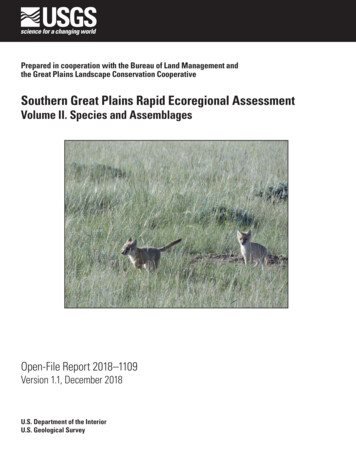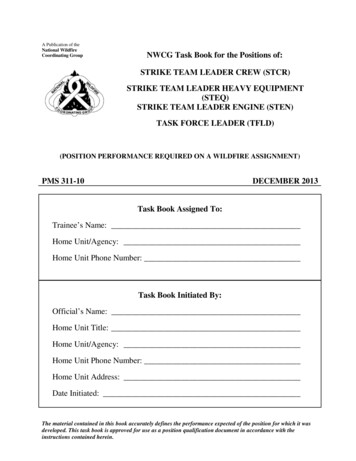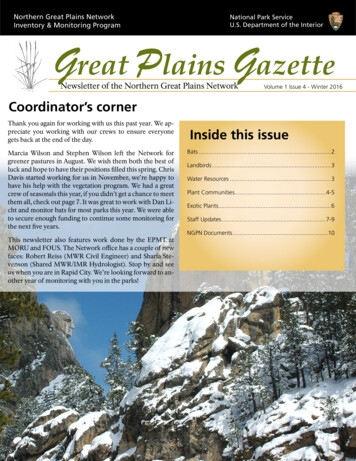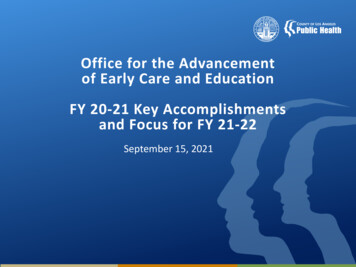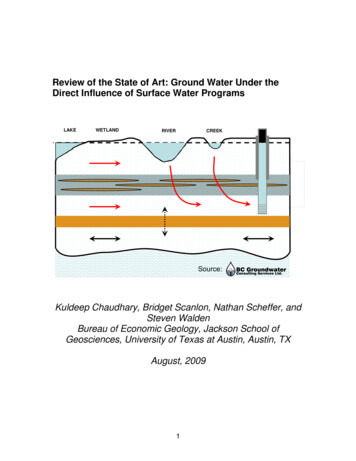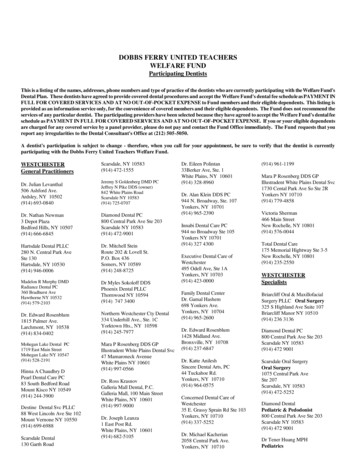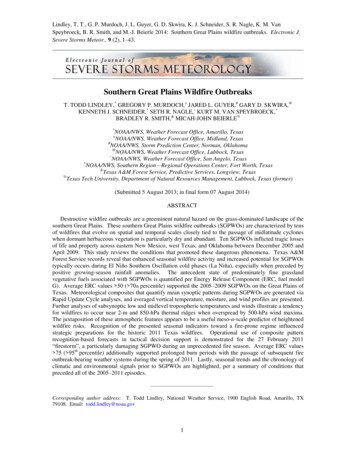
Transcription
Lindley, T. T., G. P. Murdoch, J. L. Guyer, G. D. Skwira, K. J. Schneider, S. R. Nagle, K. M. VanSpeybroeck, B. R. Smith, and M.-J. Beierle 2014: Southern Great Plains wildfire outbreaks. Electronic J.Severe Storms Meteor., 9 (2), 1–43.Southern Great Plains Wildfire OutbreaksT. TODD LINDLEY,* GREGORY P. MURDOCH, JARED L. GUYER,# GARY D. SKWIRA,@KENNETH J. SCHNEIDER,* SETH R. NAGLE, KURT M. VAN SPEYBROECK, BRADLEY R. SMITH,& MICAH-JOHN BEIERLE%*NOAA/NWS, Weather Forecast Office, Amarillo, TexasNOAA/NWS, Weather Forecast Office, Midland, Texas#NOAA/NWS, Storm Prediction Center, Norman, Oklahoma@NOAA/NWS, Weather Forecast Office, Lubbock, Texas NOAA/NWS, Weather Forecast Office, San Angelo, Texas NOAA/NWS, Southern Region—Regional Operations Center, Fort Worth, Texas&Texas A&M Forest Service, Predictive Services, Longview, Texas%Texas Tech University, Department of Natural Resources Management, Lubbock, Texas (former) (Submitted 5 August 2013; in final form 07 August 2014)ABSTRACTDestructive wildfire outbreaks are a preeminent natural hazard on the grass-dominated landscape of thesouthern Great Plains. These southern Great Plains wildfire outbreaks (SGPWOs) are characterized by tensof wildfires that evolve on spatial and temporal scales closely tied to the passage of midlatitude cycloneswhen dormant herbaceous vegetation is particularly dry and abundant. Ten SGPWOs inflicted tragic lossesof life and property across eastern New Mexico, west Texas, and Oklahoma between December 2005 andApril 2009. This study reviews the conditions that promoted these dangerous phenomena. Texas A&MForest Service records reveal that enhanced seasonal wildfire activity and increased potential for SGPWOstypically occurs during El Niño Southern Oscillation cold phases (La Niña), especially when preceded bypositive growing-season rainfall anomalies. The antecedent state of predominately fine grasslandvegetative fuels associated with SGPWOs is quantified per Energy Release Component (ERC, fuel modelG). Average ERC values 50 ( 70th percentile) supported the 2005–2009 SGPWOs on the Great Plains ofTexas. Meteorological composites that quantify mean synoptic patterns during SGPWOs are generated viaRapid Update Cycle analyses, and averaged vertical temperature, moisture, and wind profiles are presented.Further analyses of subsynoptic low and midlevel tropospheric temperatures and winds illustrate a tendencyfor wildfires to occur near 2-m and 850-hPa thermal ridges when overspread by 500-hPa wind maxima.The juxtaposition of these atmospheric features appears to be a useful meso-α-scale predictor of heightenedwildfire risks. Recognition of the presented seasonal indicators toward a fire-prone regime influencedstrategic preparations for the historic 2011 Texas wildfires. Operational use of composite patternrecognition-based forecasts in tactical decision support is demonstrated for the 27 February 2011“firestorm”, a particularly damaging SGPWO during an unprecedented fire season. Average ERC values 75 ( 95th percentile) additionally supported prolonged burn periods with the passage of subsequent fireoutbreak-bearing weather systems during the spring of 2011. Lastly, seasonal trends and the chronology ofclimatic and environmental signals prior to SGPWOs are highlighted, per a summary of conditions thatpreceded all of the 2005–2011 �––––––––––Corresponding author address: T. Todd Lindley, National Weather Service, 1900 English Road, Amarillo, TX79108. Email: todd.lindley@noaa.gov1
LINDLEY ET AL.07 August 2014the approximate time of peak burning duringeach of the 2005–2009 outbreaks. An averagedvertical profile of temperature, moisture, andwind representative of the fire-outbreakenvironment also is included. The presentedmeteorological composites illustrate an averagesynopsis of ten SGPWOs. In order to identifysubregional areas of enhanced wildfire threatwithin composite-like synoptic patterns, meso-αscale analyses of low and midtropospherictemperature and wind fields are used in aforecast funnel (Snellman 1982) approach. Thisshows that intense fire activity occurs inproximity to near-surface (2-m) and low-level(850-hPa) thermal ridges overspread by midlevel(500-hPa) wind maxima.1. IntroductionWhile not typically as intense or long-lived asforest fires, grassland wildfires present a majorthreat to life and property on the U.S. GreatPlains (Clements et al. 2007). Between 2005 and2009, ten episodes of widespread and damagingwind-driven wildfires occurred within the grassdominated vegetative fuelscape of thephysiographic region known as the southernGreat Plains (SGP) (Fenneman 1917). TheseSGP wildfire outbreaks (SGPWOs) weredistinctive both in their geographicallywidespread nature and in their severity.Cumulatively during these ten outbreaks, 287fires burned approximately 2.6 million acres (1.1million ha), 24 people were killed and 166 otherswere injured. The spatial and temporal evolutionof wildfires during these outbreak episodes, andthe atmospheric conditions supporting them,were associated with the passage of midlatitudecyclones during periods of abundant andparticularly dry, dormant, herbaceous vegetativefuels (Fig. 1).Although weather long has been recognizedas the most dynamic variable to influencewildland fire behavior (Heilman 1995),SGPWOs do not always occur whenmeteorological patterns approximate thecomposites presented in this study. As noted byBrotak and Reifsnyder (1977), non-weatherconsiderations also determine wildland firepotential. Certain infrequent combinations ofvegetative fuel and weather are prerequisite tosignificant wildfires, defined as fires 300 acres( 121 ha) in grasslands (NOAA 2007). Suchfires frequently exceed containment ability oflocal jurisdictions and require mobilization ofdistant resources for incident management. Inaddition to the day-to-day weather, other variablecharacteristics of a fire regime include climateand vegetation (Marlon et al. 2012). Complexinteractions between these factors and localshort-term meteorological conditions determinethespatialandtemporalscalesofThis manuscript consolidates and formalizespreliminary work by several of its coauthors inan effort to provide a comprehensive review ofplains wildfire outbreaks. The primary impetusof this research, however, is the integration ofmeteorological composites that identify andquantify mean magnitude and relative location oflarge-scale weather features associated withSGPWOs.Rapid Update Cycle (RUC)(Benjamin et al. 2004) analyses are used togenerate depictions of averaged geopotentialheight, wind, mean sea-level pressure (MSLP),temperature, and relative humidity (RH) insynoptic-scale composites valid at 2100 UTC,Figure 1: Infrared satellite imagery (11–3.9 µ) and 500-hPa geopotential heights (green contours)illustrating the passage of a wildfire outbreak-bearing midlatitude cyclone on 1 January 2006. Surface fire“hot spots” (Jones and Christopher 2010) are circled (red). Click image to enlarge.2
LINDLEY ET AL.07 August 2014significant fire potential. Thus, by necessity, anythorough discussion of the conditions that supportSGPWOs also must consider the interdependentinfluences of seasonal climatic variability andherbaceous vegetative responses.Therefore,discussion of meteorological SGPWO compositesis preceded here by documentation of antecedentclimatic and environmental regimes associatedwith the 2005–2009 fire outbreaks. Texas A&MForest Service (TA&MFS) seasonal wildland firereports from 2000–2010 illustrate a tendency forenhanced wildfire activity and SGPWOs to occurin Texas during cold phases of the El NiñoSouthern Oscillation (La Niña). The energyrelease component for fuel model G (ERC,Bradshaw et al. 1983) is used to apes supporting SGPWOs. The 2005–2009SGPWOs occurred when average ERCs acrosswest Texas exceeded values of 50 ( 70thpercentile).dependent vegetative fuels, and specific weatherpatterns that combine to pose a threat ofSGPWOs. Although human population andculture directly affect the continuity ofvegetative fuel regimes and the frequency ofwildland fire ignitions (Guyette and Dey 2000),this study will focus upon the atmospheric andbiophysical variables of wildland fire that areinfluenced directly by either climate or weather.2. Outbreak definition and casesUse of the term “outbreak” in meteorologytraditionally has described widespread or highend occurrences of adverse weather phenomena,such as equatorial intrusions of polar air(Glickman 2000) or episodes of numerous severelocal storms and tornadoes (Pautz 1969; Galway1977; Glickman 2000 et al.).Althoughreferences to wildfire outbreaks are common, aswith other terminology in fire weather,definitions for fire outbreaks lack standardization(Bachmann and Allgoewer 2000).In addition, an example illustrating successfulapplication of the presented concepts isdemonstrated.Recognition of fire-effectivesignals in climatic variability, including observedtrends in precipitation anomalies, ENSO, andERC influenced strategic planning by Texasofficials prior to the historic 2011 wildfire season.Composite pattern recognition-based forecastmethods were employed by fire meteorologists insupport of tactical operations prior to the 27February 2011 “firestorm”, a particularlydamaging fire outbreak that occurred during thatunprecedented fire season. Furthermore, betweenApril and June 2011, vegetative fuelscharacterized by average ERC values 75 ( 95thpercentile) supported prolonged SGPWO burnperiods. These especially critical antecedentconditions contributed to long-duration, multi-dayoutbreaks, as well as extended SGPWOs beyondtypical onset of the growing season. Lastly,although a limited dataset precludes a thoroughclimatological treatment of plains fire outbreaks,the seasonality of SGPWOs is addressed briefly,and the chronology of environmental signals priorto the 2005–2011 SGPWOs is summarized.Meteorologists preliminarily documented theSGPWO phenomenon and its relationship topassingmidlatitudecyclonesfollowingparticularly widespread and destructive fireoutbreaks that occurred during the extreme (D3)2005–2006 drought (Lindley et al. 2007). Theseearly observations were supported by findings ofupper-air troughs during high-impact wildlandfires elsewhere by Pirsko et al. (1965); Bond et al.(1967) and Finklin (1973). Brotak and Reifsnyder(1977) additionally noted that occurrences ofmajor fires typically were associated with intensemidlevel troughs (per 500-hPa geopotentialheights) and that a high degree of predictabilityfor such features meant that dangerous fireconditions could be forecast sufficiently forpreparations by fire officials.Formal researchconcerning grassfires and fire meteorology in thepredominant grasslands of the SGP, however,historically has been absent from the literature.Thus, an awareness of climate-wildland dynamicsand the specific atmospheric features thatcontribute to SGPWOs initially was not commonknowledge among forecasters in the region. As aresult, identification of synoptic-scale cyclonesthat pose a high wildfire risk initially was difficultto ascertain using numerical weather prediction(NWP) models (Lindley et al. 2006).Although this paper includes discussion ofnonmeteorological factors related to SGPWOs, itis not intended to serve as a definitive referenceon such topics. Instead, the scope of informationpresented here aims to provide fire forecasterswith a comprehensive overview of the complexinteractions between seasonal climatic variability,associated responses of predominantly grass-The ten 2005–2009 SGPWOs used togenerate conceptual models in this study werecharacterized by nearly simultaneous ignition3
LINDLEY ET AL.07 August 2014and spread of ten or more wind-driven firesspatially and temporally close to the passage ofmidlatitude cyclones. During each outbreak,wildfires burned 104–106 acres (4x103–4x105ha) across multiple states. The most severe fireactivity occurred within fine short- and mixedgrass prairies of the SGP (Fig. 2). The range ofwildfires during a few outbreaks in late 2005 andearly 2006 expanded eastward to involveincreasingly timbered vegetative fuels east of the98th meridian in northeastern Texas and easternOklahoma.These fires occurred underexceptional (D4) drought (NDMC, USDA andNOAA, cited 2006).well as population and socioeconomicconditions. Although these factors are importantin determining the overall fire regime, this studyinstead focuses upon operationally usefuldynamic seasonal and daily indicators ofSGPWO potential. This section presents theantecedent seasonal climatic variability andvegetative fuel regimes associated with the2005–2009 SGPWOs.The occurrence of these fires underscores thepotential for SGPWO-related wildfires to occurbeyond the grasslands and defined boundaries ofthe SGP in extreme conditions. Preliminary fieldobservations of wind-driven fire spread in mixedgrass prairie during outbreaks, however, suggestrates of spread (ROS) near 2.7 m s–1 (Smith2011).These measurements far exceedmaximum expected ROS in timber of 0.2 m s–1from Rothermel (1972). Thus, the extremity offire spread during SGPWOs poses a uniquedanger within the predominantly grasslandvegetative fuel environment on the plains.In addition to rapid fire spreads that consumemassive burn areas, wildfires during SGPWOsexhibit behavior that renders most firefightingtactics ineffective (Fig. 3). A consequence ofsuch rapidly spreading and intense fire behavioris the occurrence of devastating public impacts.Each 2005–2009 SGPWO caused extensiveproperty damage, and 80% of the outbreaksresulted in human deaths and/or injuries.TA&MFS officials have referred to the SGPWOphenomenon as “a ‘perfect storm’ for extremefire” and have used the term “firestorm” todescribe the most widespread and destructiveoutbreaks to impact the state (Mutch and Keller2010). Table 1 provides statistics and maps foreach of the ten 2005–2009 SGPWOs (NCDC2005; 2006a,b,c; 2008a,b; 2009).Figure 2: The central and southern Great Plains(black) and the geographic range of 2005–2009SGPWOs (red). Click image to enlarge.3. Seasonal climatic & environmental trendsThorough assessments of significant wildlandfire potential within a specific ecosystem arecommonly based upon both long-term (static)and short-term (dynamic) variables (Snyder et al.2006). Static considerations of fire risk includethe state of climate, general characteristics of thelandscape that do not vary on short timescales, asFigure 3: Extreme wildland fire behavior duringa SGPWO that renders most offensivefirefighting tactics ineffective. Photo courtesy ofthe Midland Fire Department, Midland, Texas.Click image to enlarge.4
LINDLEY ET AL.07 August 2014Table 1: Southern Great Plains wildfire outbreaks ostDeathsInjuries27 Dec 20055260 823 (24 614 ha) 19 M3414281 Jan 200643303 570 (122 850 ha) 25 M11521912 Jan 20061639 173 (15 852 ha) 600 K480012 Mar 2006271 102 044 (445 981 ha) 96 M10212116 Apr 200626119 846 (48 500 ha) 3 M420215 Apr 20061023 135 (9 362 ha) 290 K70325 Feb 200832377 568 (152 796 ha) 2.5 M51614 Mar 200829263 375 (106 584 ha) 4.5 M31004 Apr 20092333 830 (13 690 ha) 5.7 M351359 Apr 200929235 792 (95 421 ha) 47.9 M339462Mapequatorial Pacific sea surface temperatures, andspecifically identifies a vulnerability to droughton the SGP during cold phases of the El NiñoSouthern Oscillation (ENSO), or “La Niña”.ENSO is known to influence worldwideprecipitation patterns, and has been shown toaffect local weather conditions sufficiently toinfluence the frequency and extent of wildlandfire (Simard et al. 1985; Jones et al. 1999;Beckage et al. 2003). Swetnam and Betancourta. El Niño Southern Oscillation (ENSO)Climate influences wildland fire at thebroadest scale, generally through effects onseasonal cycles such as weather and thedistribution of vegetative fuels (Marlon et al.2012). Drought is a recurring climatic feature ofthe SGP (Woodhouse and Overpeck 1998).Hoerling et al. (2009) suggests that climaticfluctuations on the SGP are sensitive to5
LINDLEY ET AL.07 August 2014Figure 4: TA&MFS reported seasonal (January–April) wildland fires (left) and wildland acres burned(right) along with corresponding l (JFM/FMA) averagedONI for 2000–2010. SGPWO occurrences also are plotted. Click image to enlarge.(1990), Fye et al. (2003), Swetnam and Baiscan(2003), and Gedalof et al. (2005) have related LaNiña episodes to reduced precipitation andabundant wildfire activity, particularly in thesouthwestern U.S.elsewhere in the western hemisphere (Chen et al.2011). In addition, Johnson (1996) and Veblenand Kitzberger (2002) noted that ENSO isamong global climatic cycles that havepredictable seasonal influences on local fireregimes. While probably not a prerequisite forhigh-end fire events in the region, all of the2005–2009 SGPWOs occurred during La Niñaepisodes.The data certainly suggest thatclimatic signals associated with ENSO coldphases have predictive utility as a seasonalindicator of enhanced wildland fire risks, and thepotential for destructive wildfire outbreaks onthe SGPPreliminary work by Van Speybroeck et al.(2007) initially related La Niña and associatedSGP drought conditions to the 2005–2006 Texasfire disasters. Further evidence that supports anenhanced seasonal potential for wildfires on theSGP during La Niña is reflected in records ofwildland fire in Texas. TA&MFS data show thatboth the number of wildfires and acreage burnedacross the state generally were higher during LaNiña episodes between 2000 and 2010 (Fig. 4).Seasonal escalations of wildland fire in Texas,including the occurrence of SGPWOs, were notedduring several of the region’s climatological fireseasons (defined as January–April by Lindley etal. 2011a) when corresponding Oceanic NiñoIndex (ONI) values fell below the defined La Niñathreshold of –0.5 (Trenberth 1997). In fact, 69%of all TA&MFS-documented fires during the2000–2010 seasons, including 98% of all acreageburned, occurred during ONI-defined La Niñaconditions. An exception occurred in 2001, thesecond consecutive fire season influenced by along-lived La Niña episode. The authors suggestthat persistent drought and a limited herbaceousresponse during the growing season reduced theavailability of fine vegetative fuels andcontributed to the observed lack of enhanced fireactivity that year.b. Vegetative fuelsIn addition to local weather, ambientvegetative fuel conditions equally determine afire regime by controlling fire intensity and thepotential for fire spread (Whelan 1995; DeBanoet al. 1998). The biophysical response of nativevegetation to short-term or seasonal climaticvariation is a critical environmental variable thatinfluences significant fire potential and thelikelihood of SGPWOs.Therefore, anycomprehensive discussion of such widespreadand destructive fire episodes must consider theantecedent state of wildland vegetative fuels.The extreme fire behavior and spreadassociated with SGPWOs predominantly occurswithin fine short- and mixed-grass prairiescomprised of native buffalograss (Buchloedactyloides) and blue grama (Bouteloua gracilis)communities that dominate the SGP ecosystem(Wright and Bailey 1982). Shrub-type fuels alsoSimilar seasonal trends that relate high fireactivity to negative ONI also have been observed6
LINDLEY ET AL.07 August 2014contribute a significant component to theregion’s fuelscape (Fig. 5). Within the SGP fuelenvironment, grass is the primary catalyst forextreme rates of fire spread, while the presenceof intermixed shrub influences fire intensity andresistance to control (Scott and Burgan 2005).Thus, the predominantly grass-dependent fuelregime on the SGP readily supports widespreadwildfire outbreaks when sufficiently dormant andabundantly dry vegetation is exposed to fireeffective weather patterns.Figure 5: Landscape Fire and Resource Management Planning Tools Project (LANDFIRE) 2008 (Reeveset al. 2009) fuel models for the SGP. The geographic range of 2005–2009 SGPWOs (red outline) andsample sites for averaged ERC values also are shown. Click image to enlarge.7
LINDLEY ET AL.07 August 2014In order to quantify the state of vegetativefuels associated with the 2005–2009 SGPWOs,this study uses ERC (fuel model G). ERC is aquantity directly related to the total energy(BTU) per unit area of vegetative fuel, or thepotential heat release available for burning in theflaming zone of a fire for a specific fuel model(Bradshaw et al. 1983). Variables of ERCinclude weighted fuel loading (surface area-tovolume ratio) as well as a composite of live anddead large-fuel moistures (Cohen and Deeming1985). The ERC is a cumulative index, andapplies values from each of the previous sevendays to successive calculations. The effects ofday-to-day weather and fuel loading build overtime as live fuels cure and dead fuels dry.Therefore, in the absence of widespread firemitigating moisture or wetting rainfall, ERC haslow day-to-day variability during steady-statedrying conditions, and is an excellent indicatorof intermediate to long-term drying of vegetativefuels and (by extension) potential fire behavior.The observed five-day averaged ERCrepresentative of conditions near five cities onthe Great Plains of Texas (Amarillo, Lubbock,Midland, San Angelo, and Wichita Falls) isplottedrelativeto30-dayaveragedclimatological mean and maxima values, as wellas long term (20-y) 70th (ERC of 49), 90th (ERCof 64), and 95th (ERC of 73) percentile rankingsfor a period spanning 2000–2010 (Fig. 6). ERCdata and percentiles are presented here in thesame format that is used operationally byTA&MFS Predictive Services.Whenoccurrences of SGPWOs are plotted on the ERCcharts, the ten 2005–2009 outbreaks wereassociated with fuel regimes of ERC between 50and 70, or exceeding the long-term-averaged 70thpercentile. Daily-averaged and event-specificERC values for each of the 2005–2009 outbreaksare detailed in Fig. 7.Figure 6: Observed five-day average ERC in west Texas (black) for 2000–2010 with 30-day averagedmean (blue) and maximum values (red). Long-term (20-y) 70th-percentile, 90th-percentile, and 95thpercentile rankings are denoted. Typical growing season (May–September) is shaded green. Periods ofobserved SGPWOs shaded red. Individual SGPWOs are marked by red “*”. Click image to enlarge.8
LINDLEY ET AL.07 August 2014Figure 7: Observed daily average ERC in west Texas (black) for 2005–2010 with daily averaged mean(blue) and maximum values (red). Long term (20-y) 70th percentile, 90 th percentile, and 95 th percentilerankings are denoted. Typical growing season (May–September) is shaded green and periods ofobserved SGPWOs shaded red. ERC values associated with individual SGPWOs are detailed (orange).Click image to enlarge.wake of passing Pacific fronts reduced firedanger over the SGP as midlatitude cyclonesand their associated wind maxima translatedover the region. This conclusion is in contrastto observations of the 2005–2009 SGPWOs thatinstead were characterized by the sudden andwidespread ignition and spread of wildfiresdirectly associated with midlatitude cyclonepassages.4. Synoptic-scale compositesa. Logic and operational utilityThe most extensive research on synopticpatterns associated with critical fire weatheracross the continental U.S., including the“Southern Plains Region”, was in Schroeder etal. (1964). This research, however, was basedsolely upon airmass characteristics that promotea high ambient fire danger and did not useactual wildland fire occurrence as a verifyingmeasure. With the initial documentation ofSGPWOs that occurred in 2005–2006, firemeteorologists recognized that none ofSchroeder’s “Southern Plains Region” criticalfire weather patterns served as an acceptableanalog to the atmospheric pattern whichpromoted wildfire outbreaks in the region thatseason. The best matched pattern presented bySchroeder et al. was the “Chinook-type”characterized by strong downslope surfacewinds that overspread the SGP in associationwith a lee surface trough.That pattern,however, suggested that cold advection in theFollowing the SGPWOs of 2005–2006, fireweather forecasters immediately sought toidentify common large-scale weather featuresassociated with extreme fire episodes. Giventhe lack of documented knowledge concerningfire outbreaks on the SGP, and the complexnonmeteorological processes involved inwildland fire, preliminary work by Lindley etal. (2007) focused on the development ofmeteorological composite charts. They hopedthat recognition of future synoptic patterns thatresemble those associated with the 2005–2006SGPWOs, combined with knowledge of theseasonal state of grass-dependent wildlandfuels, would increase awareness of potentially9
LINDLEY ET AL.07 August 2014high-impact fire conditions. Such awarenessthen could lead to improved forecasts, andresult in better firefighting and emergencymanagement preparedness in advance of futureSGPWOs, as suggested by Brotak andReifsnyder (1977).warnings became apparent in 2008 and 2009,when composites derived from the 2005–2006fire outbreaks were used with operationalsuccess prior to four subsequent SGPWOevents that this study includes. Days beforeeach of those SGPWOs, meteorologistsrecognized composite-like patterns in NWPcyclone passages, and relayed forecasts of highimpact fire events to local and state officials.Texas officials considered these forecasts“imperative” for public safety (Jones et al.2013). The similarity of synoptic-scale patternsassociated with SGPWOs is illustrated via 500hPa geopotential height reanalyses (Kalnay etal. 1996) for each of the ten 2005–2009outbreaks (Fig. 9).Beebe (1956) demonstrated the utility ofmeteorological composites in operationalpattern-recognition forecasts for tornadoes.Beebe noted that the similarity of synopticscale patterns during many tornado events was“striking”, and that composite charts provide ameans for identifying large-scale atmosphericfeatures common to specific weather situations.Fire meteorologists also recognized a strikingsimilarity of large-scale patterns associated withSGPWOs characterized by the passage ofmidlatitude cyclones and strong negativegeopotential-height and MSLP anomalies (Fig.8).Thus, composite methodologies werepursued as a means to quantify the relativemagnitude and location of common synopticscale atmospheric features associated withSGPWOs.While Beebe’s tornado composites wereindependent of geographical location, SGPWOsoccur within a physiographic region whereatmospheric, biophysical and anthropogenicconditions interact to result in widespread andintense wildland fires. Thus, meteorologicalcomposites for SGPWOs are presented hererelative to geography, since the backgroundvegetative and population characteristics of theregion are contributors to the fire regime.The utility of SGPWO composites in theenhancement of fire weather forecasts andFigure 8: Composite 500-hPa geopotential height (m, left) and MSLP (Pa, right) anomalies associated withten 2005–2009 SGPWOs. Images provided by the NOAA/ESRL Physical Sciences Division athttp://www.esrl.noaa.gov/psd/. Click image to enlarge.10
LINDLEY ET AL.07 August 2014Figure 9: 500-hPa geopotential height reanalyses that show similarity between synoptic-scale upper-airweather patterns associated with ten 2005–2009 SGPWOs. Images provided by the NOAA/ESRL PhysicalSciences Division at http://www.esrl.noaa.gov/psd/. Click image to enlarge.recognized as the primary variable factors toinfluence wildfire severity (Heilman 1995).b. Composite methodologyMeteorological composites derived fromSGPWOs that occurred on 27 December 2005, 1January 2006, 12 January 2006, 12 March 2006,6 April 2006, 15 April 2006, 25 February 2008,14 March 2008, 4 April 2009, and 9 April 2009were created using RUC analyses post-processedon a 20-km grid. These composites showaveraged atmospheric fields derived from initialhour 2100 UTC analyses, the approximate peakintensity burn period for each outbreak. GEneralMeteorological PAcKage (GEMPAK) (Unidata2002) applications were used to plot computedmean grid values for a variety of parametersincluding: geopotential height and winds at the300-hPa, 500-hPa, 700-hPa, and 850-hPa levels,850-hPa temperatures, MSLP, 2-m temperature,2-m RH, and 10-m wind. The mentioned lowlevel variables were deemed relevant, given thatRH and wind are the most commonly usedmeteorological parameters in the prediction ofwildland fire behavior and spread, and they areA composite vertical profile also wasgenerated through use of 0000 UTC observedsoundings from Midland International Airport,Texas (MAF). MAF is located near the core ofthe composite surface warm and dry sector, andwas in that sector of each presented outbreakbearing cyclone.c. Wildfire-outbreak compositesAtmospheric composites for the peakintensity burn period of SGPWOs are consistentwith the passage of a deep midlatitude cycloneover the Plains. GEMPAK graphics that depictthe 300-hPa, 500-hPa, 700-hPa, 850-hPa, andnear-surface level composites, as well as anaveraged vertical sounding profile, follow (Fig.10) along with a narrative description of eachcomposite level.11
LINDLEY ET AL.07 August 2014Figure 10: 2100 UTC RUC composites for the 300-hPa, 500-hPa, 700-hPa, 850-hPa, and surface levelsalong with an averaged vertical sounding profile at MAF from ten 2005–2009 SGPWOs. Format for upperair charts includes: geopotential heights (white contours in dam), winds (cyan barbs in kt), and isotachs(shaded) 70 kt (36 m s–1) at 300 hPa, 50 kt (26 m s –1) at 500 hPa, 30 kt (15 m s –1) at 700 hPa, and 850hPa. 850-hPa isotherms 14 C are shown (red dashes). Format for surface chart includes MSLP (whitecontours), 10-m winds (cyan barbs in kt), 2-m isotherms 60 F (16 C), and 2-m RH 30% (shaded).Format for the vertical profile includes: temperature (red), dewpoint (gree
southern Great Plains. These southern Great Plains wildfire outbreaks (SGPWOs) are characterized by tens of wildfires that evolve on spatial and temporal scales closely tied to the passage of midlatitude cyclones when dormant herbaceous vegetation is particularly dry and abundant. Ten SGPWOs inflicted tragic losses
